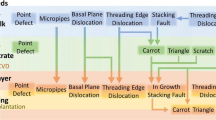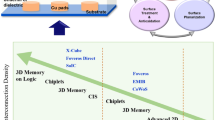Abstract
In this study, a silicon on insulator vertical super-thin body (SOI VSTB FET) is proposed and a comparative analysis of the electrical properties of SOI and conventional VSTB FET is discovered in detail. The use of suitable doping profiles significantly improves the On–Off current ratio (ION/IOFF) and sub-threshold swing (SS) of the proposed device. The SOI VSTB FET supports aggressive scaling while maintaining electrostatic integrity and low supply voltage to a large extent. The results also revealed that the SOI VSTB FET is superior in terms of Off-current (IOFF), On-current (ION), and Sub-threshold swing (SS) in comparison with the conventional VSTB FET.
Similar content being viewed by others
Data Availability
Not applicable.
References
Riordan M, Hodesson L, Herring C (1999) Reviews Mod Physics 71:S336–S345
Han K, Shin H, Lee K (2004) IEEE Trans Electron Devices 51:261–269
Tinoco JC, Alvarado J, Martinez-Lopez AG, Martino JA (2012) J Integr Circuits Syst 7:137–144
Bühler RT, Giacomini R, Pavanello MA, Raskin J (2013) IEEE Trans Micro Theory Techn 61:73–76
Skotnicki T, Hutchby JA, King T, Wong H-SP, Boeuf F (2005) IEEE Circuits Devices Mag 21:16–26
Balestra F, Webster JG (2014) Silicon-on-Insulator Devices, Wiley Encyclopedia of Electrical and Electronics Engineering, J.G. Webster (ed) Webster. https://doi.org/10.1002/047134608X.W3168.pub2
Hisamoto D, Kaga T, Kawamoto Y, Takeda E (1990) IEEE Electron Device Lett 11:36–38
Cristoloveanu S (2001) Solid State Electron 45:1403–1411
Zhang X, Connelly D, Takeuchi H, Hytha M, Mears RJ, Liu TK (2017) IEEE Trans Electron Devices 64:329–332
Maity NP, Maity R, Maity S, Baishya S (2019) J Comput Electron 18:492–499
Koldiaev V, Pirogova R (2014) U.S. Patent 8 796 085 B2
Riddet C, Alexander C, Brown AR, Roy S, Asenov A (2011) IEEE Trans Electron Devices 58:600–608
Majkusiak B, Janik T, Walczak J (1998) IEEE Trans Electron Devices 45:1127–1134
Uchida K, Koga J, Takagi SI (2003) IEEE Int Electron Devices Meet I:33.5.1–33.5.4
Omura Y, Konishi H, Yoshimoto K (2008) J Semicond Technol Sci 8:302–310
Liu Y, Ishii K, Masahara M, Tsutsumi T, Takashima H, Yamauchi H, Suzuki E (2004) Japanese J Appl Physics 43:2151
Connelly D, Faulkner C, Grupp DE (2003) IEEE Trans Electron Devices 50:1340–1345
Esseni D, Mastrapasqua M, Celler GK, Fiegna C, Selmi L, Sangiorgi E (2003) Tech Dig Int Electron Devices Meet 50:802–808
Omura Y, Konishi H, Yoshimoto K (2008) JSTS J Semicond Technol Sci 8:302–310
Hisamoto D, Kaga T, Takeda E (1991) IEEE Trans Electron Devices 38:1419–1424
Barman KR, Baishya S (2022) Silicon 14:6113–6121
Sentaurus Device User Manual, Version J (2019) 12 (Synopsis Inc.)
Colinge JP, Lee CW, Afzalian A et al (2010) Nature Nanotech 5:225–229
International Technology Roadmap for Semiconductors. (Online 2015). https://eps.ieee.org/images/files/Roadmap/ITRSFacInt2015.pdf Accessed 11 June 2021
Roy S, Chatterjee A, Sinha DK, Pirogova R, Baishya S (2017) IEEE Trans Electron Devices 64:2106–2112
Chen X, Tan CM (2014) Microelectron Reliab 54:1103–1108
Barman KR, Baishya S (2019) Appl Phys A Mater Sci Process 125:865
Barman KR, Baishya S (2019) Appl Phys A Mater Sci Process 125:401
Ranka D, Rana AK, Kumar YR, Kamalesh Y, Devendra G (2011) Int J VLSI Des Commun Syst 2:11. https://doi.org/10.5121/vlsic.2011.2102
Kumar A, Kar N, Jaiswal A, Kar A (2013) Int J App Innovation Eng Manag (IJAIEM) 2: 540
Tsividis Y, McAndrew C (2012) The MOS Transistor. Oxford University Press, Oxford
Kaharudin KE, Salehuddin F, Mohd Z, Anis S, Waffle F (2019) J Eng Sci Tech 14:2410–2430
Charmi M (2015) Chinese Phys B 24:047302
Kurniawan ED, Yang H, Lin CC, Wu YC (2018) Microelectron Reliab 83:254–259
Boukortt NEI, Lenka TR, Patanè S, Crupi G (2022) Electronics 11:91
Aziz MNIA, Salehuddin F, Zain ASM, Kaharudin KE, Radzi SA (2014) J Telecommun Electron Comput Eng 6:45–49
Kaharudin KE, Hamidon AH, Salehuddin F (2014) Int. J Eng Technol 6:2070–2079
Ferain I, Colinge CA, Colinge JP (2011) Nature 479:310–316
Author information
Authors and Affiliations
Contributions
The findings of the research gap and simulation analysis was carried out by Vikas Kumar (corresponding author) under the guidance of Srimanta Baishya and the manuscript was drafted by Vikas kumar under the guidance of Radhe Gobinda Debnath and Srimanta Baishya.
Corresponding author
Ethics declarations
We comply with the ethical standards of this journal.
Ethics Approval and Consent to Participate
We ensure that all the authors mentioned in the manuscript have agreed for authorship, read and approved the manuscript, and given consent for submission and subsequent publication of the manuscript.
Consent for publication
We give our consent to publish identifiable details to be published in the above Journal and Article.
Research Involving Human Participants and/or Animals
Not applicable.
Consent Informed
We declare that this manuscript is original, has not been published before and is not currently being considered for publication elsewhere.
We confirm that the manuscript has been read and approved by all named authors and that there are no other persons who satisfied the criteria for authorship but are not listed. We further confirm that the order of authors listed in the manuscript has been approved by all of us.
We understand that the Corresponding Author is the sole contact for the Editorial process. He is responsible for communicating with the other authors about progress, submissions of revisions and final approval of proofs.
Conflict of Interest/Competing Interests
We do not have involvement in any organization or entity with any financial interest (such as honoraria; educational grants; participation in speakers’ bureaus; membership, employment, consultancies, stock ownership, or other equity interest; and expert testimony or patent-licensing arrangements), or non-financial interest (such as personal or professional relationships, affiliations, knowledge or beliefs) in the subject matter or materials discussed in this manuscript.
We declare that there is no conflict of interest in this manuscript.
Additional information
Publisher's Note
Springer Nature remains neutral with regard to jurisdictional claims in published maps and institutional affiliations.
Rights and permissions
Springer Nature or its licensor (e.g. a society or other partner) holds exclusive rights to this article under a publishing agreement with the author(s) or other rightsholder(s); author self-archiving of the accepted manuscript version of this article is solely governed by the terms of such publishing agreement and applicable law.
About this article
Cite this article
Kumar, V., Debnath, R.G. & Baishya, S. A Quantitative Comparison Between the Electrical Characteristics of Vertical Super Thin Body (VSTB) FET and Silicon on Insulator Vertical Super-Thin Body (SOI VSTB) FET. Silicon 15, 3083–3090 (2023). https://doi.org/10.1007/s12633-022-02237-x
Received:
Accepted:
Published:
Issue Date:
DOI: https://doi.org/10.1007/s12633-022-02237-x




